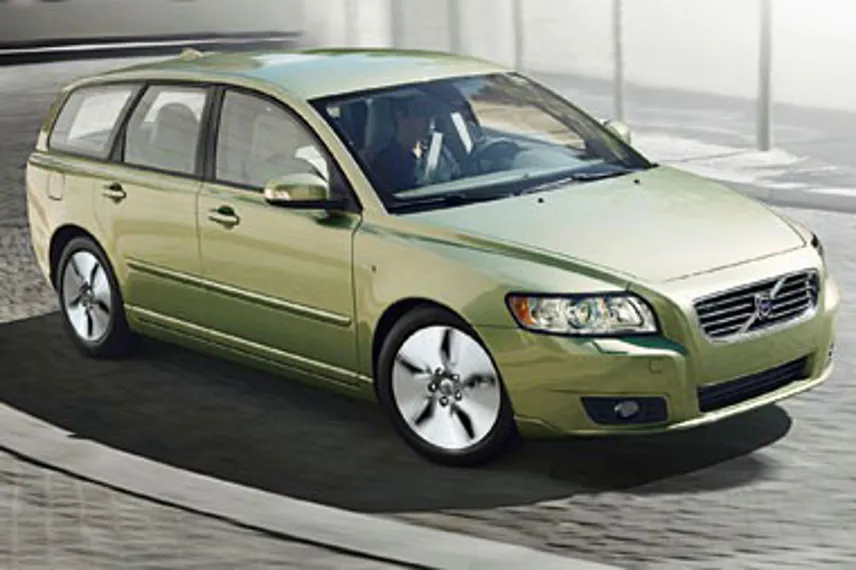Review
Volvos used to be safe, and it was their big selling point.
But then EuroNCAP ratcheted up the stakes, and with it the marketing clout of impact protection, and now all other cars are safe too, which meant Volvo’s USP became an SP, like everyone else.
Where to now then?
After dabbling with some more stylish designs, floating dashboards and snazzy lights in a bid to look more premium, Volvo has realised, like many others, that low emissions, are the name of the game and has gone after it big time with cars like this V50 DRIVe.
The advantage it has over other brands is that sporty has never been a big Volvo concern, so it can turn the wick right down with impunity.
Hence in the second half of the year you could be offering drivers a 109bhp V70.
If successful, it will show how much the market has changed, because for the last 10 years it has been about how much power you could get out of a diesel.
The V50 is an attractively designed estate, with an uncluttered interior and loadspace that makes the most of its relatively small dimensions.
The DRIVe model’s 1.6-litre diesel engine has CO2 emissions of only 118g/km and combined fuel consumption of 62.8mpg.
These are figures way below its competition, even BMW’s EfficientDynamics 3 Series.
This has been managed through a number of improvements: ride height lowered by 10mm, wind deflectors in front of the wheel, as well as lower-rolling resistance tyres and alloys than have been copied from a vegetable slicing accessory to cleave the air more cleanly.
Also the gearbox has revised ratios on third, fourth and fifth while the ECU has been reconfigured for maximum efficiency.
Thanks to the futuristic alloys and lower ride, it’s now a funky looking car, and with Volvo’s strategy of offering all the usual luxuries such as leather seats on these efficient versions, you don’t have to feel choosing one is an exercise in motoring penance.
In fact, it chugs along happily enough, but for those wanting a spot of gusto go elsewhere, because it is a slow car.
I’m looking forward to seeing just how pedestrian the V70 version will be.
But the key factor: in a week of driving the V50 DRIVe barely put any stress on the fuel needle at all. It easily did 60mpg, and that’s very impressive, because not many cars can back up their on-paper promise.
So if I was in the market for a smart, efficient estate, would I choose one?
No – not yet. Because from July even better versions will be available with stop-start and regenerative braking that take emissions down to a ridiculous 107g/km, and fuel consumption up to the mid-70s mpg.
Positives
- Low emissions
- Minimal tax bill
- Stylish looks
Negatives
- Expensive SMR
- Slow performance
- Smallish loadspace
Rivals to consider
- Citroen C5 1.6 HDi 16v VTR+ Tourer
- Ford Focus Estate 1.6 TDCi EcoNetic 110 DPF
- VW Passat Estate BlueMotion 2 TDI
P11D price
We pondered the V50’s competition.
It’s difficult because it sits between everything: premium-ish badge, smaller than the biggest estates and with a low emission engine.
That semi-premium outlook means it costs more than the larger models from the volume manufacturers.
Emissions and tax rates
With the lowest P11D and CO2 the Focus is the cheapest on BIK tax, with a lower rate payer looking at an annual bill of £501.
While it is the most expensive at the front end, the V50 is not far behind at £565 thanks to its 13% rate. The others have tax bills of more than £700.
SMR Cost
There’s a big split here, with the Passat and Focus much cheaper when it comes to SMR costs.
The Volvo would be expected to be a bit more expensive because you’re paying more for its smarter badge through higher labour rates, but the Citroën is surprisingly expensive for a volume manufacturer vehicle.
Fuel Cost
Again, the more efficient cars are the Focus and V50 thanks to their low emissions, and over 60,000 miles the Ford would use £1,300 less diesel than the much bigger C5.
However, none of these cars could be called inefficient – the C5 still manages an average of 53.3mpg.
Depreciation cost
The Volvo will be worth the most in three years and 60,000 miles, with CAP estimating it to book at £6,250 (32% of cost new), but its higher list price means it loses the most money.
The C5 will be worth £6,225 (33%), the Passat £5,600 (29%) and the Focus £4,975 (29%).
Wholelife cost
The Focus, with the best fuel economy, lowest depreciation and excellent SMR costs, is by far the cheapest in wholelife costs, as it should be.
The Passat, a whole vehicle size larger, puts in a very creditable performance. The V50 is the most expensive.
Verdict
Estate cars are such a personal choice: some are bought for all-out load volume, others for versatility every now and again, and that makes this a very difficult test to judge.
The Citroën and Volkswagen offer plenty of load volume, but are much more expensive in benefit-in-kind tax terms, while the Focus is the prosaic, workmanlike choice.
But none do all that the V50 does: it manages to be very low on company car tax and fuel consumption, has decent load space, no little style, is a pleasant (if not scintillating) drive and offers reasonable costs.
It’s not the perfect all-rounder, but its fine blend of strengths will appeal to badge-conscious and eco-minded user-choosers.
Winner: Volvo V50 1.6D DRIVe SE
















